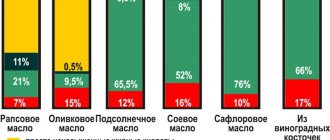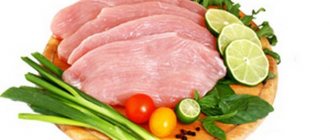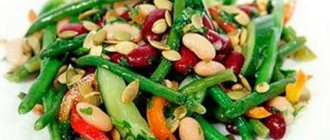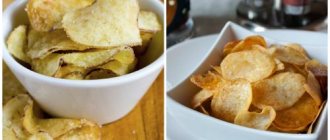Chicken eggs are a product that regularly appears on our table. Their energy value in raw form is relatively low. But not everyone is ready to drink raw eggs or make eggnog. Most often they are subjected to heat treatment: hard-boiled and soft-boiled, scrambled eggs, omelettes, and fried eggs are prepared. What is the calorie content of a fried egg? Can it be included in the diet menu? Let's take a closer look.
Chemical composition and benefits of eggs
Chicken eggs have a complex chemical composition.
So the protein contains a reserve for the formation of the embryo, antibacterial substances, ovoglobulin, and the yolk contains:
- essential amino acids (9 in total);
- carotene;
- lipids;
- lecithin.
Also, both parts of the egg contain a huge amount of macroelements (for example, potassium, calcium, phosphorus) and vitamins (A, group B, E, PP, niacin). It is generally accepted that allergic reactions are caused solely by the yolk, but this is a misleading statement. Even protein contains ovomucoid, which can lead to allergies.
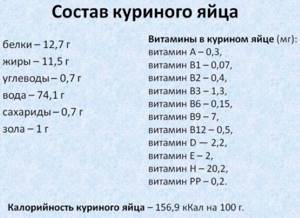
Among the beneficial properties of eggs are:
- the ability to strengthen bones and teeth;
- antitumor effect;
- prevention of vision problems (especially cataracts);
- strengthening the immune system;
- improving the functioning of the cardiovascular system.
Eggs, when consumed correctly, can speed up the healing process of gastritis, maintain the health of the optic nerve, and make the nervous system more stable. They are especially important in the diet during pregnancy. This product promotes the proper intrauterine development of the baby.
Weight of one fried egg. Scrambled eggs, fried egg - 1 small egg (40g)
Ideal weight calculator, body mass index, calorie range calculation, recommendations for weight loss, action plan.
Please note that some products may not be suitable for some people and you are strongly advised to seek medical advice before starting any weight loss or diet regimen. The weight of a boiled egg and the proportions remain the same as that of a raw one. It has been scientifically proven that the shell retains its contents well during cooking, so no changes occur.
There is also water and proteins here, but it is important to us mostly because of the third component - a natural emulsifier (I am not a chemist, but as far as I understand, an emulsifier helps to make, for example, an emulsion from water and fat, preventing it from separating).
The largest egg in the world was recorded in the Republic of Cuba. Its mass was grams. And the weight of the tiniest egg laid by a chicken in Papua New Guinea was only 9.7 grams. The weight of eggs, according to Russian legislation, is divided into groups. Because this issue is also important when selling this product in markets and stores. How much does a chicken egg weigh?
A quail egg is small in size and weight, which varies from 10 to 12 grams. Since it is possible to buy this product, which is becoming quite popular, in almost every supermarket these days, the issue of its energy value becomes relevant. One quail egg contains 16-17 kcal.
O - selected - weighs 65-75 g. Average - 70 g, if you remove the shell - 60-70 g.
A quail egg is small in size and weight, which varies from 10 to 12 grams. Since it is possible to buy this product, which is becoming quite popular, in almost every supermarket these days, the issue of its energy value becomes relevant. One quail egg contains 16-17 kcal.
This indicator is of interest primarily to the consumer, especially the fair sex, who keep their figure by counting calories. The manufacturer does not need it, since it does not affect the sorting and, consequently, the price.
Just like any other product, eggs have a number of contraindications.
- Individual intolerance. Of course, people with egg allergies will have to avoid them. Adults and especially children with hypersensitivity should also be careful - ovomucoid, contained in egg white, often causes an allergic reaction. However, in children by the age of five or six, allergies often go away on their own.
- Cholesterol. Egg yolks contain cholesterol, and this should be taken into account primarily by people prone to cardiovascular diseases. To avoid health risks, it is recommended to eat no more than two eggs per day or separate the yolk from the white. The latter is safe even in large quantities.
The weight of a chicken egg is of great importance for breeders, since it is this indicator that determines the type of product, and therefore its cost.
The mass of an ostrich egg exceeds the mass of a chicken egg 20-30 times, but the calorie content, on the contrary, is lower - 118 kcal. An average egg weighs 1200 g, and its energy value is estimated at 1400 kcal.
Based on the data, a certain conclusion can be made. Before you start egg white diets, you need to thoroughly research your condition. By listening to the doctor’s testimony, you can create an ideal diet that will replenish the body with all the necessary substances.
The section contains recipes for both teenagers and children. Some recipes are designed so that the child eats with appetite and interest.
The exact parameters of a chicken egg are not specified anywhere. We will figure out how much one egg weighs and what the weight criteria are for each category.
But you can safely eat several times more of one protein, since the yolk is considered the main source of cholesterol.
A very widely used ingredient in confectionery. I'll say even more. Eggs are added to almost all baked goods (with the exception, perhaps, of savory ones), in addition, being a structural element along with flour (structural - that is, giving shape - structure - to the finished product), absolutely necessary in desserts that are prepared without flour...
To make everything completely clear, the same is in table form. We print it above the bed too :) The latter is optional.
Harm to eggs
In addition to a possible allergic reaction, there are other negative consequences of eating eggs. But we are talking only about large portions - more often than not 2-3 times a week.
First of all, adherents of a healthy lifestyle are concerned about the high cholesterol content in eggs. To avoid possible harm from this substance, you should eat less yolks. For example, cook scrambled eggs from 2 whites and 1 yolk.
The foods discussed in their raw form are especially dangerous to the health of children and adults. There is a possibility that eggs that have not undergone heat treatment contain the Salmonella microbe. To avoid possible infection, you should wash them thoroughly before cooking with soap and cook them for at least 10 minutes.
Properties
Let's forget for a second about the calorie content of a fried egg in oil and talk about how many eggs you can eat a day to maintain health, without harm. 1-2 pieces are enough!
We also recommend: Pine nut tincture

It is better to introduce the product into the diet in the morning or afternoon; in the evening you should avoid such dishes - they take a long time to digest and be absorbed by the body. However, it is permissible to consume it on an empty stomach after drinking half a glass of water or tea.
Benefit
What beneficial properties of eggs can we talk about? The list will be impressive:
- Gives a boost of vigor and energy;
- Improves the condition of hair and nails, increases skin elasticity;
- Normalizes blood sugar levels;
- Protects against anemia;
- Removes toxins and waste;
- Improves metabolism;
- Strengthens the immune system;
- Ensures normal functioning of the nervous system and brain function;
- Stimulates collagen production;
- Reduces calorie consumption and perfectly fills you up;
- Supports vision;
- Increases muscle tone.

Harm
The calorie content of 1 fried egg is low, which allows you to eat the product while on a diet. Everything is clear about the beneficial properties - what about possible harm?
This list is short - which is great. But there is something to talk about:
- Cholesterol. Yolks contain a lot of cholesterol, it is healthy and a person needs it in reasonable quantities. However, when frying, it burns, becomes harmful and negatively affects the figure and condition of blood vessels. There is nothing to worry about if you eat no more than 1-3 eggs;
- Salmonellosis. This is a bacterium that causes acute intestinal infection - you can avoid an unpleasant “meeting” if you subject the product to sufficient heat treatment. Therefore, it is not recommended to eat raw yolks;
- Digestive problems. If you add a lot of oil when frying, you may experience flatulence, heaviness, bloating and other unpleasant consequences. It is better to stop using it if you suffer from gastritis, ulcers, pancreatitis and other gastrointestinal diseases.
You can fix the problem in a simple way - use a small amount of olive oil or avoid it altogether. It is better to serve the dish with fresh vegetables and cheese.
We counted the calories in a fried egg, looked at the beneficial and harmful properties - it's time to discuss cooking methods!
We also recommend: Fish oil and vitamin D

Energy value depending on the method of preparation and type of oil
Scrambled eggs from 2 eggs, the calorie content of which will depend on the oil used in the process and the method of heat treatment, can be both very satisfying and dietary. The maximum indicator will be obtained if the product is fried in hot fat - lard, bacon, butter.
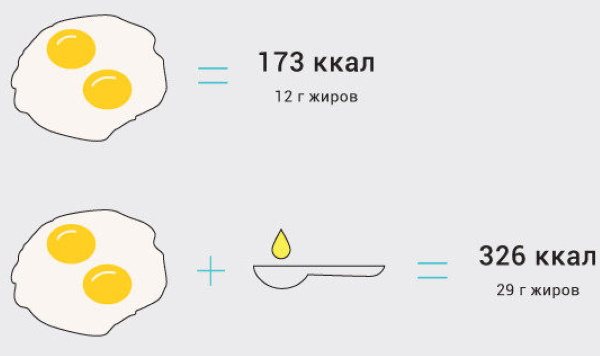
Scrambled eggs from 2 eggs. Calories with added oil.
And the minimum is if you bake it by steaming, in the oven or using a non-stick frying pan. If you don’t have any utensils on which you can fry food without oil at all, then you should use olive oil.
Calorie table for 1-2-3 eggs, per 100 g of product, ready-made scrambled eggs:
| Product/dish | Calorie content |
| Scrambled eggs from 1 egg (without oil) | 64 kcal |
| Scrambled eggs from 2 eggs (without oil) | 128 kcal |
| Scrambled eggs from 3 eggs (without oil) | 192 kcal |
| Scrambled eggs with sunflower oil | 204.7 kcal per 100 g |
| Scrambled eggs with olive oil | 141.3 kcal per 100 g |
| Scrambled eggs with butter | 217 kcal per 100 g |
| Scrambled eggs with rendered pork fat | 184.3 kcal per 00 g |
KBZHU
It is important to note that the number of calories increases significantly during heat treatment - let's talk about the calorie content of a fried egg per 100 grams!
100 grams of fried egg contains 243 Kcal!
If you like fried eggs without oil, the calorie content will drop to 184 Kcal.
Take a look at the other numbers:
- The boiled product has a calorie content of 160 Kcal;
- Raw eggs contain 157 kcal.
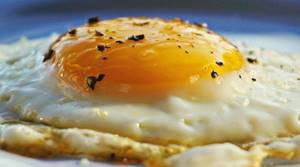
If you monitor your health and figure, create a healthy diet, you need to track the KBJU of a fried chicken egg. Calorie content has been determined, let's move on:
- Proteins – 12.8 g;
- Fats – 20.8 g;
- Carbohydrates – 0.9 g.
The BJU of a fried egg is quite well balanced - you will get a huge part of the daily requirement of elements from 1-2 pieces. This is how much you can eat daily.
We figured out how many carbohydrates are in fried eggs, found proteins and fats, determined calorie content - let's talk about other components!
How to reduce the calorie content of scrambled eggs?
To make scrambled eggs less caloric, when frying them, you should completely exclude fat or choose olive/coconut oil.
There are other ways to reduce this indicator:
- replace 1 of the yolks with a white (you will end up with 3 whites per 1 yolk in the dish);
- use water instead of oil, pouring it in a thin layer onto the frying pan before frying and pour the egg mixture on top after heating;
- prepare a dish only from proteins and do it by steaming (for example, in a slow cooker);
- replace half the egg mass with vegetables - broccoli, tomatoes, zucchini, white onions, asparagus;
- serve the treat with fresh cucumbers, cabbage, and plenty of greens (as a result, the serving size will increase, but the caloric value per 100 g will decrease).
How many calories are in protein?
Before answering this question, let’s consider what chicken protein consists of. It turns out that 80% to 85% of egg white is just water. Fat in egg white is no more than 0.5-1% of its composition. Proteins account for 12.5-14%, carbohydrates – up to 1%. It is this composition that explains the low calorie content of egg white.
Protein accounts for up to a quarter of the calories of the total calorie content of the product. As a rule, the white of one egg contains from 15 to 20 kilocalories.
Having a low calorie content, egg white is not without a lot of beneficial properties. It contains B vitamins, enzymes (dipepsidase, protease, diastase) and amino acids necessary to maintain normal functioning of the human body.
How to use on a diet?
Eating eggs on a diet is possible and even beneficial for the body. A healthy person can eat up to 3 eggs per day. It is best to divide them into 2 meals. For example, in the morning cook low-calorie scrambled eggs from 2 pcs. for breakfast, and in the evening have 1 boiled egg with vegetables for dinner.
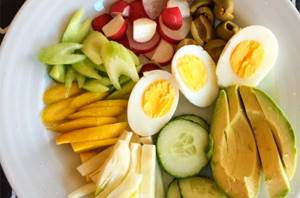
Steamed eggs are also an excellent option for eating on a diet. It has minimal calorie content. If the dish is prepared exclusively from proteins, then it is allowed to eat it even 2-3 times a day.
It is worth combining eggs with permitted broths - for example, vegetable and chicken, with a variety of vegetables and herbs. If bread is added to a diet dish, then you should choose whole grain bread without yeast.
Duck, quail, turkey: which eggs are healthier?
But don't stop at just chicken eggs. Today, quail, duck, turkey and even ostrich eggs are sold on store shelves. In terms of the quality of the prepared dish, they are in no way inferior to chicken, but each has its own beneficial properties and calorie content. Let's try to figure it out.
Quail eggs
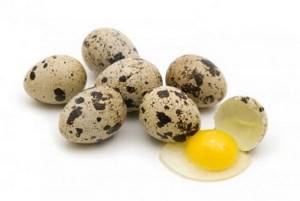
The very small spotted eggs have already won the hearts of many healthy food enthusiasts and chefs. They are considered the most useful, and people call them natural vitamins. Quail eggs are practically no superior to chicken products in terms of the amount of vitamins, but they contain much more phosphorus, iodine, calcium, iron and potassium.
How many calories will be in the finished quail egg dish depends on the additional ingredients, for example:
- two fried eggs - only 30 kcal;
- in 100 g of omelette with milk - 72 Kcal;
- in scrambled eggs with bacon – 138 Kcal.
Despite the rich composition and low energy value, such a breakfast is strictly contraindicated for children under 1 year of age. Quail eggs should also be given to children under 5 years of age with caution to avoid severe allergic reactions. But such eggs are a great addition to any weight loss diet.
Turkey eggs
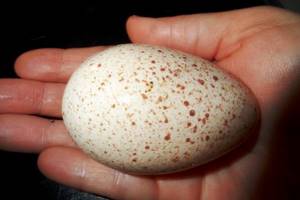
If you are pursuing another goal and want to gain muscle mass, you should turn your attention to turkey eggs. The calorie content of 100 g of such a dish will be approximately 171 Kcal. In addition, regular consumption of turkey eggs will improve brain function, boost immunity, and strengthen teeth, nails and hair. Very often, doctors recommend including them in the diet of people suffering from high stomach acidity.
Duck eggs

Duck eggs, which have an interesting bluish hue, can also hardly be called a dietary product. Due to the high fat content, their calorie content exceeds the 185 Kcal mark, and this is only in its pure form without additives. But this does not mean that they are less beneficial than chicken products. In fact, duck eggs lead in iron, calcium and phosphorus content. In addition, only they contain amino acids essential for the human body.
Is it possible to lose weight on eggs?
Losing weight on eggs is quite possible. There are even special egg diets designed for three days. With a balanced diet, the product can be included in the menu up to 4 times a week. Doctors do not recommend pampering yourself with eggs more often: this can have a bad effect on the kidneys and liver. The product is great for breakfast when combined with a vegetable salad. Eggs will add satiety to your meal and satisfy your hunger for a long time due to their high protein content.
If you want to lose weight, you need to ensure that eggs have as little calories as possible. This is easy to do if you choose the appropriate type of preparation of the product. It is ideal if you include boiled eggs in your menu, supplementing them with plenty of fiber. But lovers of omelettes or scrambled eggs can get creative and bake the delicacy in the oven or steam it without oil.
This is very easy to do. A multicooker or, if you don’t have one, a regular saucepan and a colander with small holes are suitable for this. You need to boil water in a saucepan and place a colander in it so that it does not touch the liquid. Break the egg into an omelette pan that has been previously greased with oil. Do not be afraid that fats will be involved in the preparation of the dish. Oil is only necessary to prevent the scrambled eggs from sticking to the walls. In addition, steaming does not release harmful carcinogens.
Place the pan with the egg in a colander, cover with a lid and cook until done. The calorie content of such a dish will be 6-7 times less than after frying. And you can enjoy your favorite scrambled eggs without jeopardizing your figure.
Knowing how many calories are in an egg, you can accurately calculate your diet for weight loss. And so that your favorite product doesn’t get in the way of your path to slimness, don’t overeat and leave the table a little hungry.
BZHU, composition
A chicken egg, regardless of weight, consists of 73% water. Proteins account for 13% of the mass, fats make up 12%, the remaining 2% are carbohydrates and mineral salts. The yolk is the most nutritious part. It is where most of the vitamins (A, D, E, F, K, PP, group B), microelements (phosphorus, calcium, iron, magnesium, etc.), polyunsaturated and saturated fatty acids are concentrated.
The bulk of the fat is also included in the yolk, so its energy value is three times higher than that of the white.
Calorie content per serving according to different recipes
When adding any components to scrambled eggs, you should remember that the energy value of the finished dish will directly depend on this. Some products can almost double this figure.
Popular recipes:
| Additional Ingredients | Amount per serving of two eggs, g | Cooking method | Kcal in finished portion |
| Bacon | 100 | Cut the bacon into thin strips, fry on both sides without oil; break the eggs, add salt to taste | 440 |
| Milk sausages (2 pcs.) | 110 | Cut the sausages into slices, fry in vegetable oil; pour in eggs, fry for 3-4 minutes | 510 |
| Tomatoes and onions | Tomatoes-95; onion - 50 | Fry the onion with sunflower oil until golden brown; add the tomatoes cut into pieces, simmer for 2-3 minutes, pour in the eggs (stir if desired) | 340 |
| Champignon mushrooms) | 75 | Cut the champignons, fry with vegetable oil for 3-5 minutes; pour in the beaten egg mixture, fry covered until done | 240 |
| Croutons (wheat bread) | 100 | Cut the bread into small cubes, fry for 1-2 minutes in sunflower oil; pour in the eggs, fry covered over low heat for 3-4 minutes | 575 |
| Cheese and greens | Russian cheese - 50; dill - 10 | Pour the beaten egg mixture into a heated frying pan; after 2 minutes add chopped dill and grated cheese | 420 |

